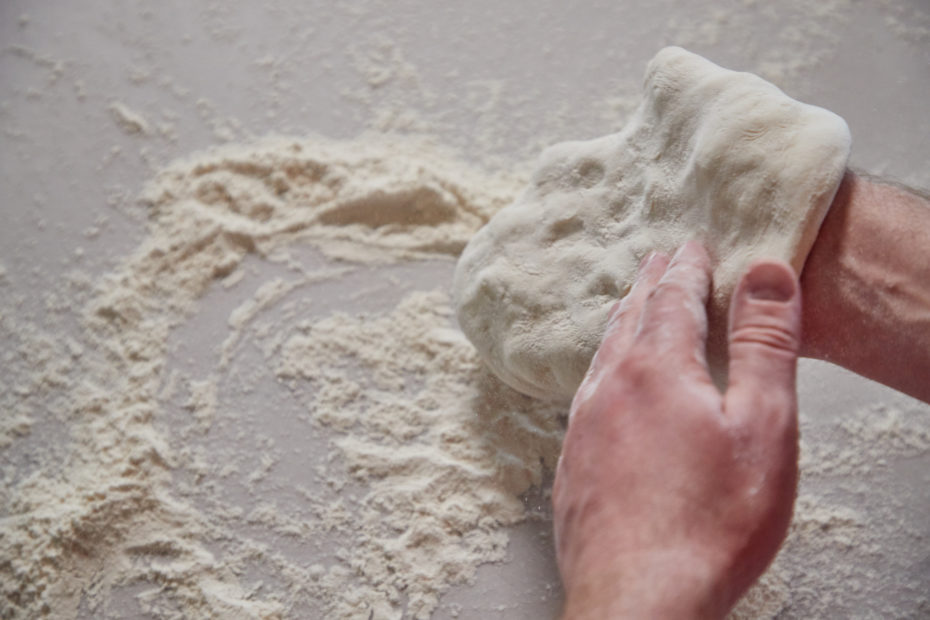Something magical happens when you allow yeast to work. It produces beer, bread, wine… in fact, a whole myriad of culinary delights. The process of fermentation is over 10,000 years old—and it’s an integral part of the pizza dough you love, too. Fermenting pizza dough makes the pizza lighter, tastier, and easier to digest.
What is it?
During fermentation, yeast transforms carbohydrates into alcohol (that’s what’s responsible for the crust’s aroma and its soft texture) and carbon dioxide (creating the air pockets that bubble up in the oven). Yeast needs some time to do all that, and proper fermentation gives it that time.
Bread, which also uses flour and yeast, is different from pizza in that it finishes the process while it’s baking in the oven. Pizza, on the other hand, uses ovens to heat and brown, not to transform, so any fermentation in the dough has to happen before the pizza goes into the oven. How can that work?
The answer is long fermentation. Dough that’s shaped and proofed after a slow, cold fermentation demonstrates noticeably better flavor and more of the crunch and chew we all love.
How long is long?
With fermentation timing is essential. Pizzeria Locale ferments its pizza dough from 24 to 36 hours to obtain the best balance and flavor; that is really the “sweet spot” for fermentation.
This long fermentation calls for minimal kneading and lots of resting. The longer fermentation time allows proteins in the dough to tangle and form stronger bonds. That makes the dough more elastic and gives Pizzeria Locale’s pizza crust its signature chew and crunch.
How does it work?
First of all, we mix the water, flour, salt, and yeast (the only ingredients Pizzeria Locale ever uses for its dough). There are two main proteins in flour, and mixing the ingredients interconnects them and forms an elastic bond between them.
Next, the dough is put aside to rest and rise, and this is when fermentation begins. The yeast starts digesting carbohydrates and the gluten continues to get stronger. Bubbles are slowly inflating, and they continue the stretching process on their own as they do.
After the dough has rested, we shape it onto balls and then it goes back for a second rise. The gluten loosens and the carbon dioxide bubbles are inflating still more.
After the second rise, we stretch the dough, preparing it for the oven. Heat works together with fermentation to produce the perfect pizza, with the crust getting the right crispy texture without becoming dry; pizza ovens are extremely hot, which adds black bubbles and crunch. Now the air pockets inside the dough can expand so it rises and inflates as the carbon dioxide leavens the dough, leaving the crust light, crisp, and with a beautiful color.
What’s yeast got to do with it?
Many pizzerias use a sourdough starter in their pizza dough. We don’t. We use active dry yeast, because that helps keep the dough consistent day after day. “It’s how you make the dough that’s essential,” says Gino Sorbillo, one of Naples’ most famous pizzaoli, and we couldn’t agree more!
If fermentation is so good, why not go longer?
Leaving the dough to ferment for too long will change its flavor, as the sugars in the dough continue to convert to alcohol. The resulting aroma is pretty sour—not something you’re looking for in a pizza crust! If we allow the dough to ferment for too long it can also be over-proofed, making the dough more dense and somewhat flat. So we’ve learned the sweet spot of fermentation for perfect pizza crust every time.
Leave it to us!
At Pizzeria Locale, we’ve spent years creating true Neapolitan pizza dough using only flour, salt, yeast, and water, creating superior flavor and texture. The magic of fermentation is the final touch which makes our pizza dough so special.



